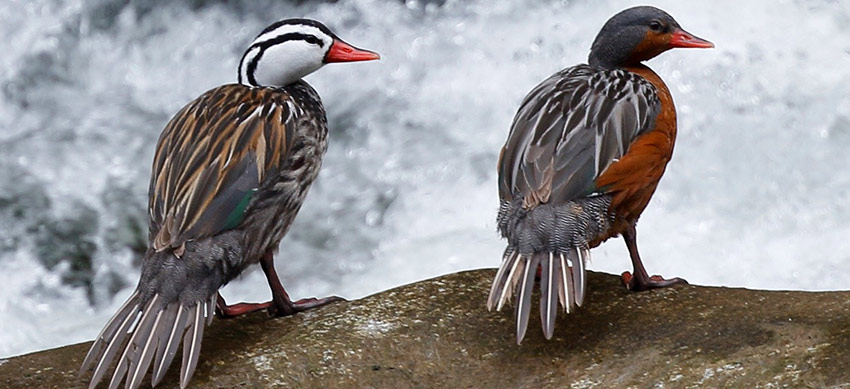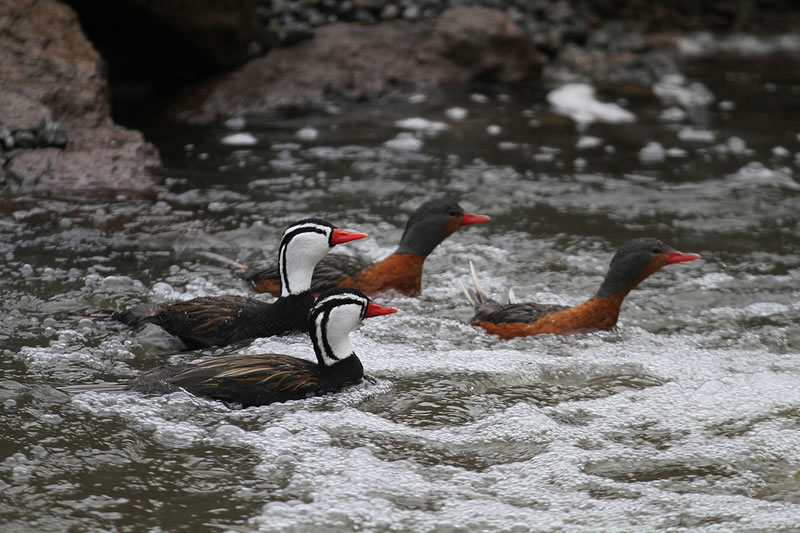
As its name suggests, this duck inhabits fast-flowing streams in the Andes Mountains. Its most notable feature is that they rest on the rocks. It is able to swim against the current with apparent ease. On the Inca Trail to Machu Picchu it is possible to see it in the torrents of the Vilcanota River. It is one of the most characteristic species of this hiking route.
The Duck of Machu Picchu
- The torrent duck is one of the most famous species that inhabit the Vilcanota river, located on the banks of the Historic sanctuary of Machu Picchu.
- They are excellent swimmers. They can swim upstream very close to the bottom from where they get their food. They are very territorial and sedentary. They cover territories between 700 meters and 3 kilometers, depending on the abundance of food in the river they inhabit.
- Males use their dewclaws to fight off potential invaders. Normally they nest in pairs, but in the breeding season the territory is shared by parents and chicks.
- The torrent duck has the longest incubation period of all the ducks in the world: a month and a half. They reproduce in the dry season when rivers have lower water levels. In this way they ensure the survival of the youngsters.
- The female is in charge of caring for and incubating the 3 or 4 eggs she lays, under the dedicated supervision of the male. When the chicks are born, they are cared for by both parents until they are 4 or 5 months old.
Characteristics
- The torrent duck has unique characteristics that differentiate it from the rest of its relatives. A thin and flexible reddish beak, adapted to get its food between rocks and crevices in the river bed. Lightweight torpedo-shaped body, long and rigid tail that allows it to maintain balance in the strong currents of mountain rivers.
- The male has a white head with black on the forehead. They also have a strip that goes down from behind to the base of the neck. Another black stripe from below the eye to the throat. Black eyepiece retro stripe. Sides of the neck white with a black line. Its back has a scapular region black feathers bordered with white. On the front it has a black front throat of the neck and chest. Also a reddish abdomen speckled with black. Its flanks are blackish tinged with reddish. The smaller wings are grayish blue. The older ones show a white limb.
- The female has a head with a gray crown. The back of the cheeks and sides of the neck are black and gray. The back shows a black region with blue-gray edged feathers. The ventral part shows a throat, chest and abdomen, cinnamon. The rest is equal to the male. Both have a deep orange beak.
Description
- Scientific name: Merganetta armata.
- Family: Anatidae.
- Subfamily: Tadorninae.
- State of conservation: Minor concern.
- Male: White head with black lines.
- Female: Gray head with rust-colored underparts.
- Height: They can reach 38 to 46 centimeters.
- Latitude: They live from 1,500 to 4,500 meters above sea level.

Duck of the torrents Inca trail Machu Picchu
Inhabit
- It inhabits cold, fast-flowing rivers in the Andes mountains of South America. It is possible to see them at altitudes from 1,500 to 4,500 meters above sea level. Sometimes it can be seen at altitudes close to sea level, although always in cold waters.
- Its habitat is distributed from Venezuela to Tierra del Fuego in Argentina, passing through countries such as Colombia, Ecuador, Peru, Bolivia and Chile.
- This species does not migrate. This characteristic makes it very vulnerable, since the progressive pollution of the rivers represents a risk in the future of the duck of the torrents.
More information
- The flora and fauna of the Inca Trail is amazing. In addition to the torrent duck during the walk, visitors can appreciate the famous cock of the rocks, considered the national bird of Peru.
- The torrent duck feeds mainly on fish and crustaceans that it gets by diving in rivers. Its incubation takes between 44 days approximately. Their nests are placed on the banks of rivers, especially in the dry season (from May to September).
- In Peru the torrent duck can be subdivided into four other different species: a) Merganetta armata leucogenis. b) the Merganetta armata turneri. c) the Merganetta armata garleppi. d) the Merganetta armata berlepschi. These differences are in color.
- During the Inca Trail to Machu Picchu it is possible to observe torrent ducks on the banks and rocks of the Vilcanota River. This river is several meters away from the Inca trails. Therefore, good vision is required to distinguish these birds.
By Inca Trail Machu Picchu - Last updated, 22-08-2024
Interested in the Inca Trail? Know more about Nature!
- Coca leaf, ideal for trekking in Peru
- The Cantuta flower. Where to find it on the Inca Trail?
- Fauna of the Inca Trail
- Spectacled bear on the Inca Trail to Machu Picchu
- The cock of the rocks on the Inca Trail
- Inca Trail: butterfly observatory
